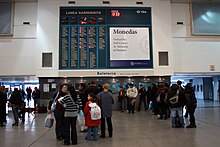Once railway station
Once de Septiembre | |
|---|---|
 Station building, c.1900. | |
| General information | |
| Location | Av. Pueyrredón and B. Mitre Buenos Aires Argentina |
| Owned by | Government of Argentina |
| Operated by | Trenes Argentinos (Sarmiento Line) Ferrobaires (Long distance services) |
| Platforms | 7 |
| Tracks | 8 |
| Connections | Underground |
| History | |
| Opened | 20 December 1882 |
| Electrified | Third rail |
Once railway station (Template:Lang-es), IPA: [ˈonse]) is a large railway terminus in central Buenos Aires, Argentina in the barrio of Balvanera.
The station, inaugurated on December 20, 1882, is located in the barrio of Balvanera immediately north of Plaza Miserere, a large public square. The station is named after the September 11, 1852, rebellion of Buenos Aires against the Federal government of General Justo José de Urquiza.[1] Coincidentally President Domingo Faustino Sarmiento also died on September 11 (1888), but contrary to popular belief in Argentina, this is not the date commemorated by the station's name.
History
Background and first buildings




The Buenos Aires Western Railway was the first railway line of Argentina, having been opened in August 1857 joining Del Parque station (where currently Plaza Lavalle is located) to Flores district of Buenos Aires through 10-km. length. The first intermediate stop was named "Once de Septiembre".
That first Once de Septiembre station was a modest building made of wood and placed on Bartolomé Mitre street. It had only one platform and some warehouses to store wood and other materials. The increasing growth of Buenos Aires as a consequence of mass immigration to Argentina meant the closure of Del Parque railway station, therefore Once became the terminus. A new building was built for that purpose, which was inaugurated on January 1, 1883. The building was made of wood.[2]
The continuous expansion of Buenos Aires produced a growth of road traffic with a large number of trams and carriages in the city. By the 1890s new groups of immigrants established near Once station.
The original terminal, an unassuming clapboard structure, was ordered to be replaced by larger facilities following its 1890 purchase by the Buenos Aires Western Railway. Designed by architect John Doyer, the new, Renaissance Revival terminal was built in two stages, from 1895 to 1898, and then from 1906 to 1907; refurbishment works completed in 1972 removed most of the terminal's ornate, cast-iron roof trusses (though these are still visible in the adjoining subway station).
Rail accidents
On February 22, 2012, a commuter train entered Once station traveling at an excessive speed, about 26 km/h, and crashed into the buffers at the end of the line, killing 51 people and injuring at least 703.[3]
A similar, though less severe, incident took place on the morning of October 19, 2013, when a commuter train crashed into the buffers and landed on the platform above.[4] Passengers reported that the conductor was speeding from Caballito Station (the previous stop);[5] a crowd of passengers surrounded the control booth following the crash yelling "murderer", though the conductor had already fled.[6] The conductor, Julio Benítez, was arrested after he was found with the train event recorder hidden in his backpack; Benítez had attempted to destroy the device.[7]
Services
Estación Once handles both long-distance and local passenger trains. The publicly owned provincial railway company Ferrobaires operates trains over four principal rail lines which fan out west over the surrounding Buenos Aires Province. Destinations include Pehuajó, Bragado, Bahia Blanca and points between.
Additionally, the commuter rail State-owned company Trenes Argentinos S.E. operates a regular train service to the suburbs of Buenos Aires along the branches of its Sarmiento Line to destinations including Moreno, Luján, Lobos, and Mercedes. The station is accessible by numerous public bus services and by the A line of the Buenos Aires Underground via its "Plaza Miserere" station. Estación Once underwent extensive renovations prior to 2007, when the new H line of the metro reached the heavily transited terminal.
Gallery
-
View of the station's facade.
-
Entrance to Line A of the Buenos Aires Underground.
-
A Trenes de Buenos Aires train leaving the station, prior to the company's nationalisation.
-
A postcard from 1910 showing the station.
-
Historical photo of the station c.1910.
See also
- Rail transport in Argentina
- Sarmiento Line
- Domingo Faustino Sarmiento Railway
- Balvanera
- Del Parque railway station
References
- ^ Balvanera on Barriada website
- ^ Arquitectura Ferroviaria by Jorge Tartarini, Google books
- ^ "Argentine Train Slams Into Station, Killing 49". The Associated Press. February 22, 2012.
- ^ "Dozens hurt in Buenos Aires train wreck". CNN. October 19, 2013.
- ^ "Un tren del Sarmiento chocó contra el andén 2 de la terminal de Once". Info News.
- ^ "Otra vez chocó un tren contra el andén en Once: 80 heridos". Clarín. October 19, 2013.
- ^ "El motorman se llevó el disco rígido con las imágenes de la cámara de seguridad del tren". Info News. October 19, 2013.





